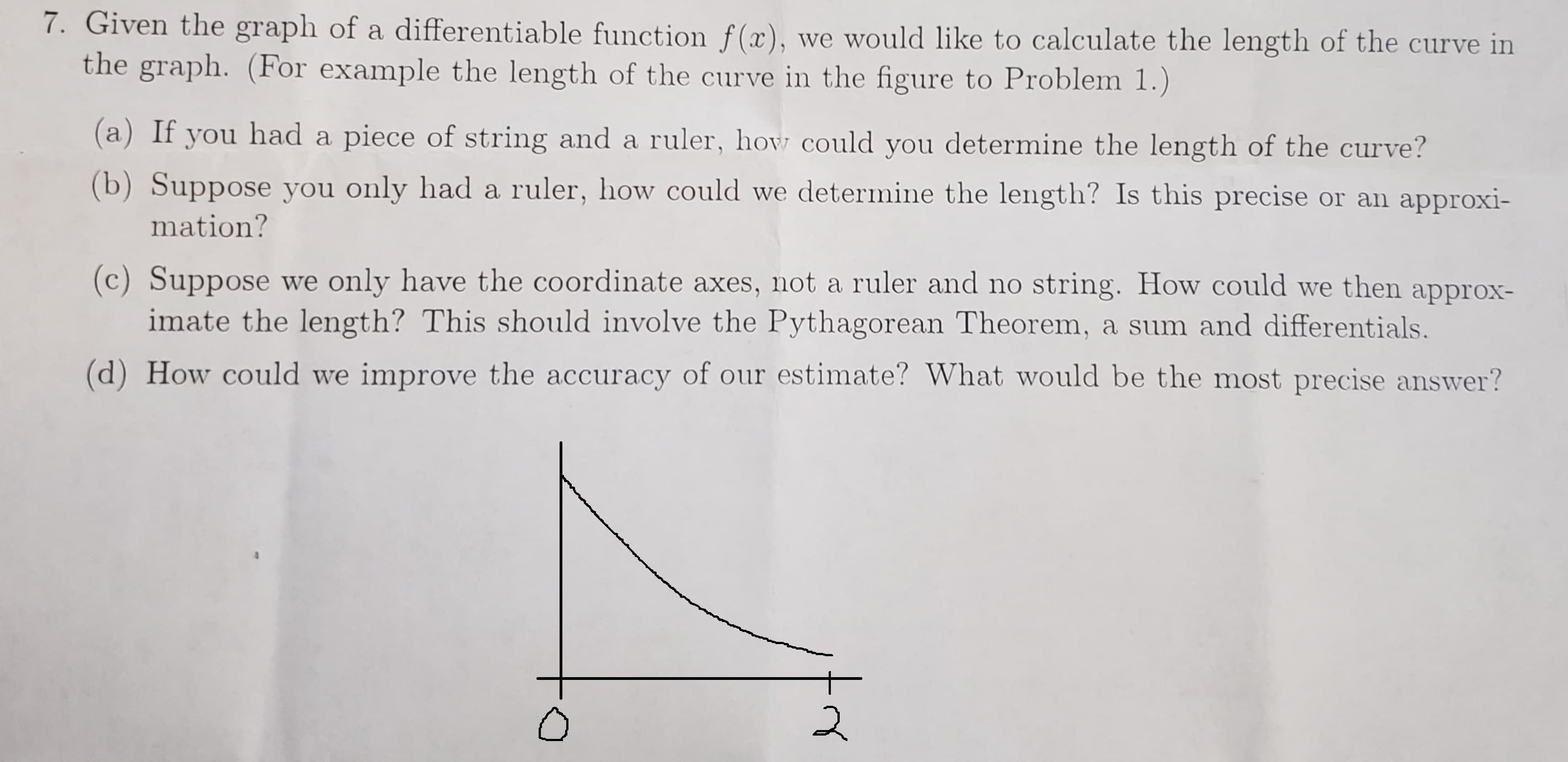7. Given the graph of a differentiable function f(x), we would like to calculate the length of the curve in the graph. (For example the length of the curve in the figure to Problem 1.) (a) If you had a piece of string and a ruler, how could you determine the length of the curve? (b) Suppose you only had a ruler, how could we determine the length? Is this precise or an approxi- mation? (c) Suppose we only have the coordinate axes, not a ruler and no string. How could we then approx- imate the length? This should involve the Pythagorean Theorem, a sum and differentials. (d) How could we improve the accuracy of our estimate? What would be the most precise answer?
7. Given the graph of a differentiable function f(x), we would like to calculate the length of the curve in the graph. (For example the length of the curve in the figure to Problem 1.) (a) If you had a piece of string and a ruler, how could you determine the length of the curve? (b) Suppose you only had a ruler, how could we determine the length? Is this precise or an approxi- mation? (c) Suppose we only have the coordinate axes, not a ruler and no string. How could we then approx- imate the length? This should involve the Pythagorean Theorem, a sum and differentials. (d) How could we improve the accuracy of our estimate? What would be the most precise answer?
Calculus: Early Transcendentals
8th Edition
ISBN:9781285741550
Author:James Stewart
Publisher:James Stewart
Chapter1: Functions And Models
Section: Chapter Questions
Problem 1RCC: (a) What is a function? What are its domain and range? (b) What is the graph of a function? (c) How...
Related questions
Question

Transcribed Image Text:7. Given the graph of a differentiable function f(x), we would like to calculate the length of the curve in
the graph. (For example the length of the curve in the figure to Problem 1.)
(a) If you had a piece of string and a ruler, how could you determine the length of the curve?
(b) Suppose you only had a ruler, how could we determine the length? Is this precise or an approxi-
mation?
(c) Suppose we only have the coordinate axes, not a ruler and no string. How could we then approx-
imate the length? This should involve the Pythagorean Theorem, a sum and differentials.
(d) How could we improve the accuracy of our estimate? What would be the most precise answer?
Expert Solution
This question has been solved!
Explore an expertly crafted, step-by-step solution for a thorough understanding of key concepts.
This is a popular solution!
Trending now
This is a popular solution!
Step by step
Solved in 6 steps with 6 images

Recommended textbooks for you

Calculus: Early Transcendentals
Calculus
ISBN:
9781285741550
Author:
James Stewart
Publisher:
Cengage Learning

Thomas' Calculus (14th Edition)
Calculus
ISBN:
9780134438986
Author:
Joel R. Hass, Christopher E. Heil, Maurice D. Weir
Publisher:
PEARSON

Calculus: Early Transcendentals (3rd Edition)
Calculus
ISBN:
9780134763644
Author:
William L. Briggs, Lyle Cochran, Bernard Gillett, Eric Schulz
Publisher:
PEARSON

Calculus: Early Transcendentals
Calculus
ISBN:
9781285741550
Author:
James Stewart
Publisher:
Cengage Learning

Thomas' Calculus (14th Edition)
Calculus
ISBN:
9780134438986
Author:
Joel R. Hass, Christopher E. Heil, Maurice D. Weir
Publisher:
PEARSON

Calculus: Early Transcendentals (3rd Edition)
Calculus
ISBN:
9780134763644
Author:
William L. Briggs, Lyle Cochran, Bernard Gillett, Eric Schulz
Publisher:
PEARSON

Calculus: Early Transcendentals
Calculus
ISBN:
9781319050740
Author:
Jon Rogawski, Colin Adams, Robert Franzosa
Publisher:
W. H. Freeman


Calculus: Early Transcendental Functions
Calculus
ISBN:
9781337552516
Author:
Ron Larson, Bruce H. Edwards
Publisher:
Cengage Learning